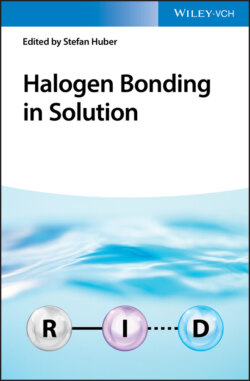Читать книгу Halogen Bonding in Solution - Группа авторов - Страница 36
1.5.2 Liquid Crystals
ОглавлениеThe LC state is a mesophase, having properties of both crystalline solids and isotropic liquids, with extensive real‐world applications. A variety of different noncovalent interactions are employed to achieve desired LC properties (e.g. low temperature formation, unique light modification, predictable phase transition, etc.), but hydrogen bonding is by far the most common [170]. The success of hydrogen bond‐mediated LCs is largely attributed to its directionality, thereby inspiring evaluations using the more stringent halogen bond. In fact, LCs incorporating halogen bonds have exhibited unique properties dissimilar to hydrogen bonding derivatives. This section provides select examples of how the halogen bond has been applied to produce different classes of LCs. For further reference, a recent review of the topic has been published [171].
The first example of LCs assembled by halogen bonding was reported by the Bruce lab in 2004 [172]. Here, alkoxystilbazole derivatives were used as halogen bond acceptors and pentafluoroiodobenzene as the donor (Figure 1.17). X‐ray crystallographic studies suggested the LC formation resulted from a CI⋯N halogen bond. The dimeric complex formed LCs only when cooling, known as monotropic formation. However, alkoxystilbazoles with longer alkyl chains (n > 6) resulted in enantiotropic LCs (occurring at both heating and cooling cycles). Exchanging the iodine donor for a weaker bromopentafluorobenzene precluded LC formation. The LC formation temperature was lower for the halogen bond derivatives than hydrogen bonding analogues – a property that is generally beneficial for LCs operating near room temperature (e.g. liquid crystal display [LCD] displays). Many other early halogen bond LCs incorporated iodoperfluorobenzene donors, as they form moderately strong halogen bonds and are readily available for purchase [173–176]. However, in 2013, Bruce used molecular iodine as a halogen bond donor to create LCs with stilbazole acceptors [177]. The high temperature stability (>200 °C) of the mesophase was attributed to the intermolecular iodine–iodine contacts. These initial examples demonstrate the ability of the halogen bond to facilitate LC formation with favorable properties.
Figure 1.17 The first example of a halogen bonding LC developed by Bruce. Alkyl chains R related to LC behavior.
The Bruce lab, along with Metrangolo and Resnati, also contributed to the first example of ionic LCs using halogen bonds [173]. Using tricomponent imidazolium cations and neutral perfluoroiodo halogen bond donors bound to iodide, they showed that the alkyl chains on the organocations did not drive liquid crystallinity and even smaller chain lengths (n = 2) formed a mesophase. Later studies made these systems light responsive [178].
Photoresponsive LCs, used in displays, nanotechnology, and photo‐driven devices, provide on–off switchable liquid crystallinity. Toward this end, the halogen bond has been integrated into photoresponsive LCs. For example, Priimagi et al. [175] paired the photoactive azo group on a halogen bond donor with an alkoxystilbazole acceptor to produce UV‐active halogen bonding LCs (Figure 1.18). Separately, neither of these molecules exhibited an LC phase, but together they induced anisotropy when irradiated with polarized UV light. Replacing a CH hydrogen bond donor in tetrafluorobenzene with an iodo halogen bond donor in iodotetrafluorobenzene resulted in a decrease of the phase‐transition temperature that was dependent on the concentration of iodoperfluorobenzene, along with improved chiral light absorption [179].
The Li group doped commercially available achiral LCs with chiral halogen bonding molecular switches to produce helical cholesteric LCs (CLCs) [180]. The CLCs operate reversibly under thermal or light response. Reflection colors for these CLCs were temperature dependent, producing red, green, and blue colors. Additionally, the helical twisting power (HLC), known as the amount of chiral LC formation, could be altered by UV light interacting with the halogen bond CLCs. This concept shows that halogen bonding can be used to optimize doped LC systems to create photonic devices.
